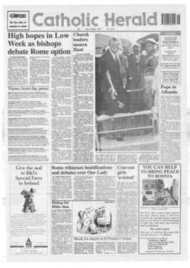Page 8, 23rd April 1993
Page 8

Report an error
Noticed an error on this page?If you've noticed an error in this article please click here to report it.
Tags
Share
Related articles
The Real Meaning Of Icons
I N 1987, Pope John Paul Ii Published Duodecimum Saeculum...
Darkened Cavern For Icon Display
What Is An Con?
Deliver God's Message From The Comfort Of Your Home
Early iconographers who prepared with much fasting and prayer
IN Christian tradition an icon is a painting of Christ, the Holy Family, Saints or Feast Days executed on wood. The word itself means 'image" in Greek and the image is the very essence of Christianity since Christianity is not only the very revelation of the word of God but equally, through divine incarnation, of the image of God. There were portraits of Christ and the Apostles created during his lifetime, the fact noted by Bishop Eusebius in his History of the Church (4th century).
However, nothing has been preserved to our time as vast amounts of icons were destroyed in the inconodastic purges of the 8th century. When the split in the Christian Church occurred in 1054, it was the Byzantine Orthodox Church which continued the tradition of icons as objects of dogma and prayer.
The tradition was introduced to Eastern Europe and Russia around the 10th century by travelling Greek monks. It was indeed Russia which carried further that perfection of pictorial language of the icon which recreated the full meaning of its liturgical image. Today, when we talk about style in iconography, we mainly think about the Byzantine or the Russian school.
The oldest image in iconography is associated with Christ himself. It is called Mandillion the icon painted by no human hand. Christ's face, miraculously imprinted on a piece of cloth, was sent to King Abgar of Edessa to cure him of fitness. This icon of Christ stresses the doctrinal truth of orthodox Christianity icons are not artistic creations only; but the image of the living truth. St Luke is generally accepted to be the first iconographer who created portraits of Mary the Mother of God with the infant Jesus. There are 17 icons of the Mother of God attributed to him.
Also attributed to St Luke, the icons of Eleusa underline the humanity of the Mother of God. Little Jesus is turned towards his mother and holds his hand around her neck. Their cheeks touch each other. This icon, quite rare in Byzantium, became one of the principle themes of Russian icon painting. The most famous example is the Vladimir Mother
of God (11th century).
Painting icons is like a prayer. It is a spirited act of communication with God and preparations for it require fasting and prayer. The iconographers of the past were in most cases unknown monks who fasted and prayed for days when painting icons.
Some of them were canonised as saints after their deaths. The greatest and most famous Russian iconographer is St Andrey Robley (14th century). The first place among his work is occupied by the Trinity. His art is
distinguished by great harmony and sense of colour. I would refer those interested in his life and work to an epic Russian film by Tarkovsky called Rziblep.
The 14th and 15th and the first half of the 16th centuries represent the finest period of Russian iconography.
Incidentally this period produced the greatest number of canonised saints in Russia: 50 between 1420 and 1500. This was also the time when the Byzantine Empire fell to the Tasks and its iconography went into decline.
Peter Kowal
blog comments powered by Disqus











